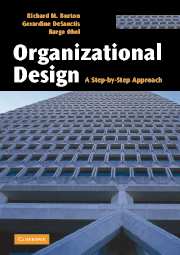Book contents
- Frontmatter
- Contents
- List of figures
- List of tables
- Preface
- An outline of the step-by-step approach
- Step 1 Getting started
- Step 2 Strategy
- Step 3 Structure
- Step 4 Process and people
- 6 Task design
- 7 People
- 8 Leadership and organizational climate
- Step 5 Coordination and Control
- Applying the step-by-step approach in a dynamic world
- References
- Index
7 - People
- Frontmatter
- Contents
- List of figures
- List of tables
- Preface
- An outline of the step-by-step approach
- Step 1 Getting started
- Step 2 Strategy
- Step 3 Structure
- Step 4 Process and people
- 6 Task design
- 7 People
- 8 Leadership and organizational climate
- Step 5 Coordination and Control
- Applying the step-by-step approach in a dynamic world
- References
- Index
Summary
Introduction
“An enterprise is its people,” so stated the famous Japanese industrialist Matsushita Konosuke. Like many successful business leaders, Matsushita believed that effective management of people was an essential ingredient to a firm's ability to reach its goals (PHP Institute, 1994). From an organizational design perspective the question for the executive is: what is the best way to manage people, given the organization's goals, strategy, structure, and task design? As is the case for other dimensions of design, multiple approaches are possible. Deciding among these approaches depends on two critical factors: the number of people in the organization and their professionalization. The organization and the people must fit together. Depending on the design choices you have made with regard to goals, strategy, structure, and task, different approaches to managing people are recommended.
We will deal with the people dimension of organizational design in two ways. In this chapter you will describe the size and capabilities of a firm's workforce. These dimensions affect the firm's information-processing capacity. In the next chapter you will assess the leadership and organizational climate of the firm. These dimensions affect the ability of people to handle information and make decisions.
We defined the organization in Chapter 1 as a social entity, so it follows that how you manage the people in your firm depends on how many people you employ and the kinds of capabilities they bring to the organization. Managing people is a complex matter, and many factors might be considered.
- Type
- Chapter
- Information
- Organizational DesignA Step-by-Step Approach, pp. 122 - 134Publisher: Cambridge University PressPrint publication year: 2006



